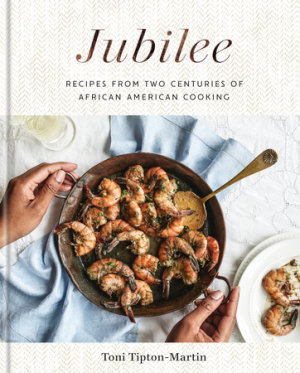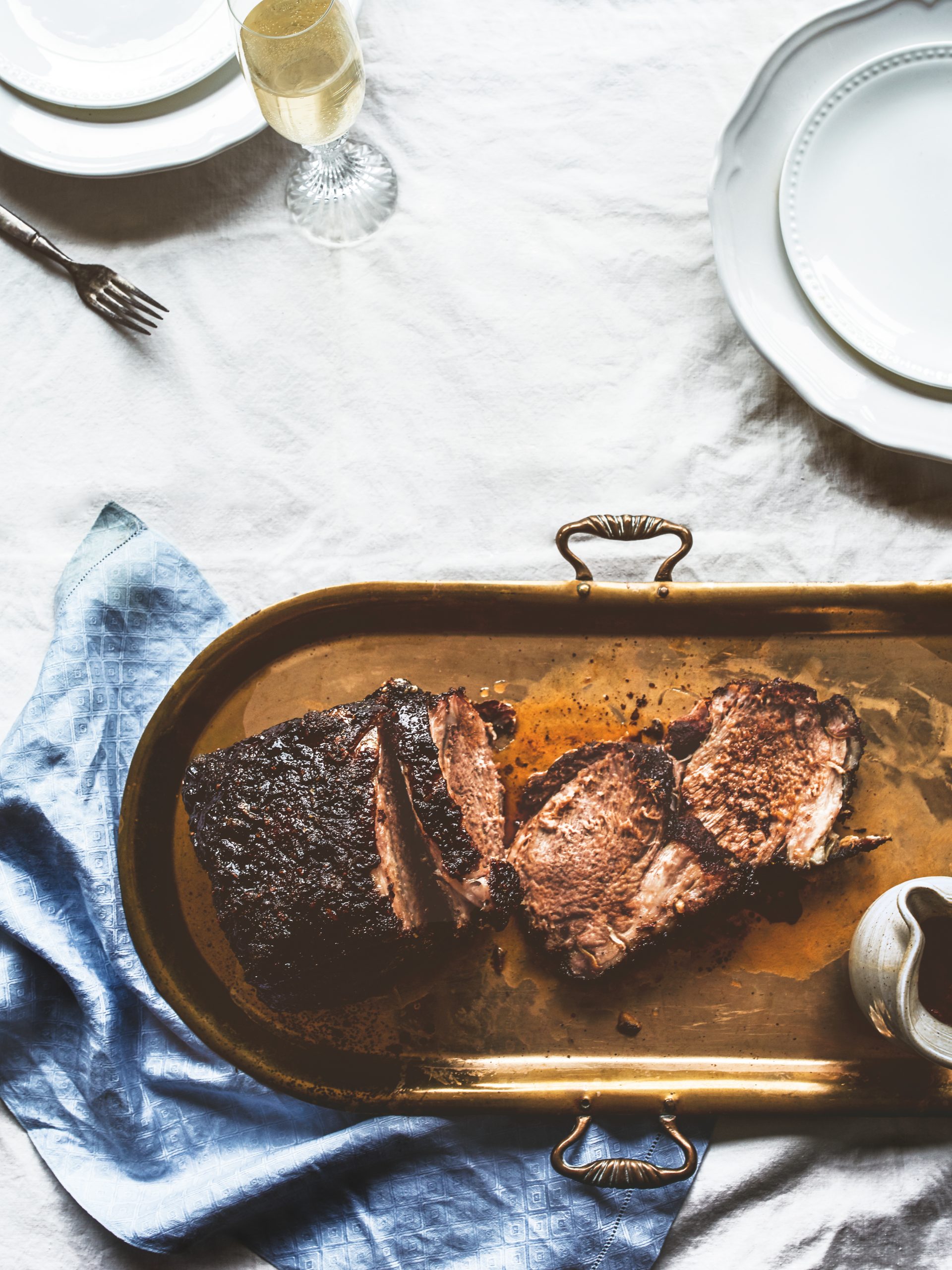Excerpts
Celebrate Black Cooking with Barbecued Pork Shoulder and a Cucumber Cooler Cocktail
Toni Tipton-Martin shares the rich history of African American food and mixology with these recipes from her cookbooks Jubilee and Juke Joints, Jazz Clubs, and Juice: A Cocktail Recipe Book

Culinary journalist, community activist, and two-time James Beard Award winner Toni Tipton-Martin is dedicated to highlighting the too often-ignored contributions to American cuisine made by Black chefs and home cooks. Her cookbooks are instructional and provide historical context, and celebrate the varied and rich traditions of African-American cooking and the diversity of the dishes. In an interview with Shondaland, Tipton Martin reveals that the title of her cookbook, Jubilee, “is an expression, a way to capture our freedom to cook in the ways that inspire us, and excite us, and bring us joy.” Read an excerpt from Jubilee below, then start cooking two of Toni’s recipes — one for Barbecued Pork Shoulder and another for a Cucumber Collins, a cocktail featured in her new book, Juke Joints, Jazz Clubs and Juice.
As I knelt on the cool hardwood floor in my home office, surrounded by books that span nearly two hundred years of black cooking, I realized my ancestors had left us a very special gift: a gift of freedom, culinary freedom. And like the Biblical Jubilee that marks restoration of a people through deliverance, rest, and land conservation, and like Jubilee Day celebrations marking the emancipation of enslaved Americans, our culinary Jubilee is also about liberation and resilience. Our cooking, our cooks, shall be free from caricature and stereotype. We have earned the freedom to cook with creativity and joy.
Barbecue and Roast Pork
“The thirty-thousand-year-old practice of cooking over an open fire continues to be an integral part of Africa’s culinary heritage,” Heidi Haughy Cusick explained in Soul and Spice: African Cooking in the Americas. “In Togo today, street vendors cook michui, spicy skewered fish and meat, over charcoal. In Mali, whole goats are still ceremoniously roasted for weddings and other special occasions. Sidewalk vendors from West Africa to the Caribbean grill plantains to eat as a snack or with spicy grilled meats or stews; and in Bahia they carry small lighted charcoal-filled drums with grates on top for cooking fresh cheese.”
But when we think of American barbecue, images of well-seasoned ribs, brisket, whole hog, and poultry slow-roasted and smoked over hardwood charcoal replace Old World techniques that grilled quickly over an open flame. The practice is attributed to the Taino, an Arawak tribe in the West Indies, who preserved food by smoke-drying it over a pit fire on a wooden grate called a barbacoa. Spanish explorers brought the device and the word to the American Southeast during the early sixteenth century. By 1709, the word “barbecue” was in use in America; it had taken on the implications of a social gathering by 1733; and George Washington mentioned attending a barbecue in his journal in 1769, according to The Encyclopedia of American Food & Drink.
The enslaved barbecued whole suckling pigs, called shoats, during hog killing time. Mutton and rabbits went into the pit to celebrate special occasions. And when the meat on the grill was of poor quality, they fashioned a barbecue sauce from spicy red peppers mixed with vinegar to mask the taste. After the Civil War, barbecuing became an integral part of Juneteenth celebrations.
I love the story of Bluebill Yancey, one of those “pit artists” whose legendary barbecue was a fixture of Mississippi politics during the mid-1930s. Candidates hired him often because his barbecue brought “dead enemies” together to chat “as if food and drink have eradicated all differences,” a WPA interviewer recalled. Yancey was eccentric, too. He cooked according to the stages of the moon, believed that the presence of women stopped the meat from breathing freely, used chicken fat in his mop sauce, and paced “ceaselessly—up one side to turn the meat, down the other to baste it”—all night long. Yancey’s secret sauce of vinegar, bay leaves, lemon, pickling spices, onion, and generous amounts of garlic and paprika is a throwback to the plantation legacy that miraculously transformed simple meats into an American tradition.
This legacy was remembered by pitmaster Wesley Jones. In the Slave Narratives, Jones described a similar barbecue ritual on a South Carolina farm: “Night befo’ dem barbecues. I used to stay up all night a-cooking and basting de meats wid barbecue sass. It made of vinegar, black and red pepper, salt, butter, a little sage, coriander, basil, onion, and garlic. Some folks drop a little sugar in it. On a long pronged stick I wraps a soft rag or cotton fer a swab, and all de night long I swabs dat meat ’till it drip into de fire. Dem drippings change de smoke into seasoned fumes dat smoke de meat. We turn de meat over and swab it dat way all night long ’till it ooze seasoning and bake all through.”
Barbecue—and its cousin, roast pork—is one of those everlasting dishes: a mainstay on our menus, whether it’s a dish of pulled or chopped pork roast, spareribs, or baby backs nursed in a ten-foot pit with wire mesh stretched over smoldering hot coals. From Puerto Rican–seasoned back bones to shoulder roasts rubbed with Creole spices or marinated in Jamaican jerk seasonings and citrus juice, our barbecue is kissed with a touch of the African diaspora.
BARBECUED PORK SHOULDER (Serves 8–10)
Heidi Haughy Cusick celebrated the tastes and textures of the American South, plus Brazilian, Creole, and Caribbean cuisines, in Soul and Spice: African Cooking in the Americas. She discovered a smoky sandwich meat with a recipe much like this one in Memphis, Tennessee, that recalls the mop sauces pitmasters have used for generations to deeply infuse meat with flavor during the long, slow cooking process. It is boldly spiced, moist, and absolutely delicious with its pairing of dark, sweet, mysterious molasses barbecue sauce.
- 1 (4- to 5-pound) pork shoulder, bone-in or boneless
- 1 tablespoon garlic powder
- 1 tablespoon salt, or to taste
- 1 teaspoon black pepper
- 1 teaspoon cayenne pepper
- 1 teaspoon smoked paprika
- ¼ cup vegetable oil
- Molasses Barbecue Sauce (recipe follows), for serving
Place the pork on a board and pat it dry with paper towels. In a large zip-top plastic bag, combine the garlic powder, salt, black pepper, cayenne, smoked paprika, and oil. Add the pork to the bag, close the bag, and turn it over several times to thoroughly coat the pork with the spice paste. Refrigerate for at least 8 hours, or overnight.
Prepare a charcoal fire on one side of a barbecue grill or heat one side of a gas grill. When the temperature inside the grill is 250°F, place the pork on the cooler side of the grill, away from the heat. Cover the grill and grill the pork, turning occasionally, until a meat thermometer inserted in the center of the meat reaches 185°F, 3 to 4 hours. Add additional wood or coals as needed to maintain the temperature at 250°F. (Use smoke chips, if desired, according to manufacturer’s directions, if using a gas grill.) Remove the pork to a board and let stand for 10 minutes. Use a sharp knife to slice the pork across the grain and chop. Or, when cool enough to handle, use a fork to pull the pork into shreds. Serve with Molasses Barbecue Sauce.
MOLASSES BARBEQUE SAUCE (Makes about 2½ cups)
- 2 tablespoons butter
- 1 garlic clove, minced
- 2 tablespoons minced onion
- 1⅓ cups ketchup
- ¼ cup cider vinegar
- ¼ cup molasses
- 1 tablespoon Worcestershire sauce
- 1 tablespoon fresh lemon juice
- 2 tablespoons brown sugar
- 2 teaspoons yellow mustard
- ½ teaspoon smoked paprika
- ½ teaspoon cayenne pepper
- ½ teaspoon salt
- ¼ teaspoon black pepper
- ¼ teaspoon chili powder
In a saucepan, heat the butter until sizzling. Add the garlic and onion and cook over medium-low heat until tender, about 2 minutes. Stir in ½ cup water, the ketchup, vinegar, molasses, Worcestershire sauce, lemon juice, brown sugar, mustard, smoked paprika, cayenne, salt, black pepper, and chili powder. Bring to a boil over medium-high heat, then reduce the heat to a gentle simmer, cover, and cook for 20 minutes to allow the flavors to mingle.



CUCUMBER COLLINS
The standard Tom Collins combines gin, lemon or lime juice, and carbonated water in a tall, cylindrical glass. The cooling summertime libation is an ideal option for exploring the various flavors that master distillers rely upon to make their gins unique. Sometimes, I like Old Tom gin for its smooth, mild juniper notes, but in this lovely cocktail a more fragrant gin really shows off when combined with lemon juice and the melon-like notes of cucumber.
I could not resist fidgeting with the Cucumber Splash in Melba’s American Comfort so as to up my Collins game. Melba Wilson is owner of the iconic Harlem restaurant Melba’s, and is the creator of a fried chicken recipe that won Bobby Flay’s Throwdown! competition on his Food Network television program. In her 2021 book, Melba muddles a thick slice of cucumber in the bottom of a cocktail shaker, then adds Hendrick’s gin, elderflower liqueur, and lemon juice. The elderflower’s floral undertones take the place of sugar or simple syrup; it’s a perfect foil for the aromatic gin, which is infused with rose and cucumber. I also love this drink with Maior gin, a delicate Spanish spirit distilled from Mediterranean figs, rosemary, and orange botanicals. For my version, I upped the gin, lemon, and soda for more punch and a more refreshing effervescence.
- 1 (½-inch-thick) slice of peeled cucumber
- 2 ounces (¼ cup) gin of choice (preferably Hendrick’s or Maior)
- 1 ounce (2 tablespoons) St-Germain Elderflower liqueur
- 2 tablespoons fresh lemon juice
- Ice cubes
- Crushed ice
- ½ cup lemon-flavored sparkling water
- 1 lemon twist or peeled cucumber slice
In a cocktail shaker, muddle the thick cucumber slice until juicy. Add the gin, liqueur, and lemon juice. Fill with ice cubes. Shake hard for 10 seconds to mix well. Fill a Collins glass halfway with crushed ice. Strain the gin mixture into the glass and top off with the sparkling water. Garnish with the lemon twist or cucumber slice. Serves 1.



Introduction and Barbecued Pork Shoulder and Molasses Barbecue Sauce recipes reprinted with permission from Jubilee: Recipes from Two Centuries of African American Cooking by Toni Tipton-Martin, copyright © 2019. Photographs by Jerrelle Guy. Published by Clarkson Potter, a division of Penguin Random House, Inc.
Cucumber Collins recipe reprinted with permission from Juke Joints, Jazz Clubs and Juice by Toni Tipton-Martin, copyright © 2023. Photographs by Brittany Conerly. Published by Clarkson Potter, a division of Penguin Random House, Inc.











